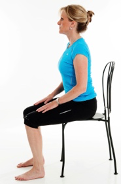
Lower back pain is a common condition affecting many individuals at some point throughout their lives. It is one of the main causes of high treatment costs, sick leave and suffering (Meucci, Fassa and Faria 2015). Having persistent lower back pain for more than 3 months is classed as chronic back pain. This is something we see a lot of in clinic.
What is the main cause of lower back pain?
A common cause of lower back pain is restricted, long held positions such as sitting desk bound or standing for long periods of time (Abu-Naser and Aladhdoo 2016).
Posture?
Now we’d be lying if we said we haven’t heard of the famous sayings ‘perfect posture’ or ‘proper posture’. However, these desired positions are somewhat unrealistic; why are we trying to alter the way we naturally hold ourselves both standing and sitting? (Gilman 2018).
Instead of drastically changing something that is very innate and subconscious to us, why don’t we get up and move just that little bit more frequently?
Can movement help with lower back pain?
With lower back pain being most commonly seen in people who live sedentary lifestyles it is so important to elicit movement as and when we can! Sometimes fear of exacerbating pain can prevent people in having the confidence to create movement around that lower back. A study conducted by Meucci, Fassa and Faria (2015) showed that back pain significantly reduced, by 52.5% in people who participated in both functional and aerobic training.
***3 TIPS for reducing your symptoms of lower back pain***
Get up and move every 20 mins throughout the day, especially if you spend a lot of time sitting!
Seated roll downs
Sit comfortably in a chair where your feet can be flat on the floor
Place the palms of your hands on your thighs
Slide your hands down the fronts of your legs, as far as you can go pain free.
Hold at this bottom range for 3 seconds
Slide back up to the original start position
Complete 3x10 of these!
Hollow body holds

Lay on your back with your arms in the air and hips and knees in a flexed position
Think about reaching as far as you can with your arms whilst driving your belly button/lower back into the floor.
Ensure you are not holding your breath and if someone was to ask you a question- you could answer! We do not want any purple faces!
Hold for 30s x 5-8 time a day
These tips are a great place to start if you are experiencing generic lower back pain. However, if after trying these you feel that you have not improved or reached a plateau then you may benefit from seeking some further advice/treatment. At Injury Active we will complete a thorough consultation including; a subjective history, objective markers, treatment and rehabilitation.
If you need help managing your lower back pain then feel free to get in contact.
Olivia Freeman
BSc Hons Sports Therapy MSST
MSc Strength and Conditioning
07761887778
References
Abu-Naser, S. S and Aldahdooh, R (2016, ‘Lower back pain expert system diagnosis and treatment’, Journal of Multidisciplinary Engineering Science Studies, 2(4), 441-446.
Gilman, S. L (2018), Stand up straight! A history of posture, Reaktion Books, London, England.
Meucci, R. D, Fassa, A. G and Faria, N. M, X. (2015), ‘Prevalence of chronic low back pain; systematic review’, Revista de saude publica, 49(1), 73.




Comments